University Report: Constructs of Interest and Black Women in Workplace
VerifiedAdded on 2022/11/25
|7
|1552
|455
Report
AI Summary
This report explores the constructs of interest, focusing on the emotional effects of colorism and hair texture discrimination, and their influence on impostor syndrome among Black women in the workplace. The report defines key terms such as colorism, discrimination based on hair texture, and impostor syndrome, highlighting their impact on Black women's psychological well-being and professional identity. It discusses the scales of measurement, including nominal, ordinal, interval, and ratio scales, and their relevance in assessing social constructs. The report emphasizes the use of Likert scales for measuring perceptions related to colorism and hair discrimination, explaining the advantages and limitations of such measurement types. It also touches on statistical concepts like correlation and regression, providing a comprehensive overview of the constructs and methodologies used to study their effects.
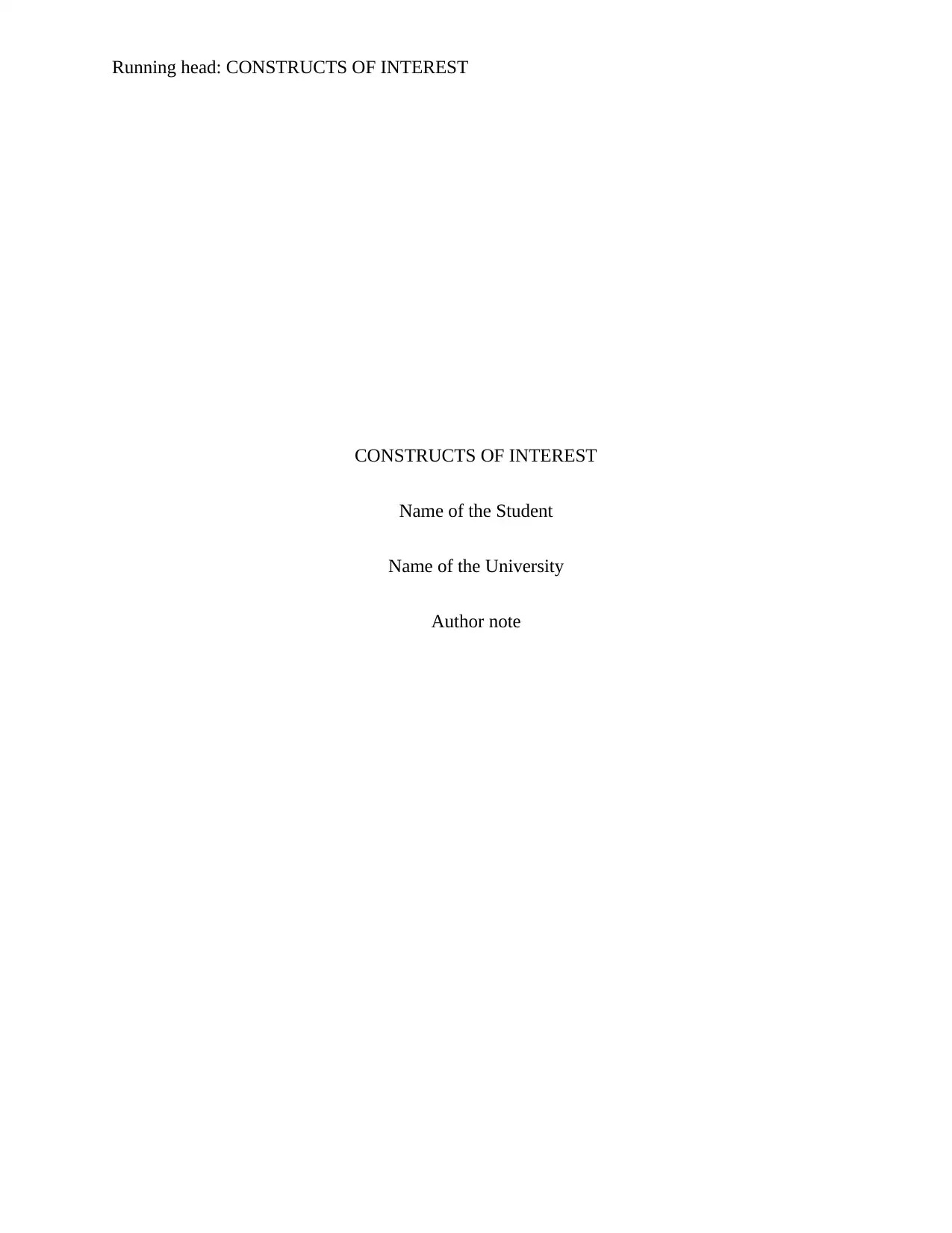
Running head: CONSTRUCTS OF INTEREST
CONSTRUCTS OF INTEREST
Name of the Student
Name of the University
Author note
CONSTRUCTS OF INTEREST
Name of the Student
Name of the University
Author note
Paraphrase This Document
Need a fresh take? Get an instant paraphrase of this document with our AI Paraphraser
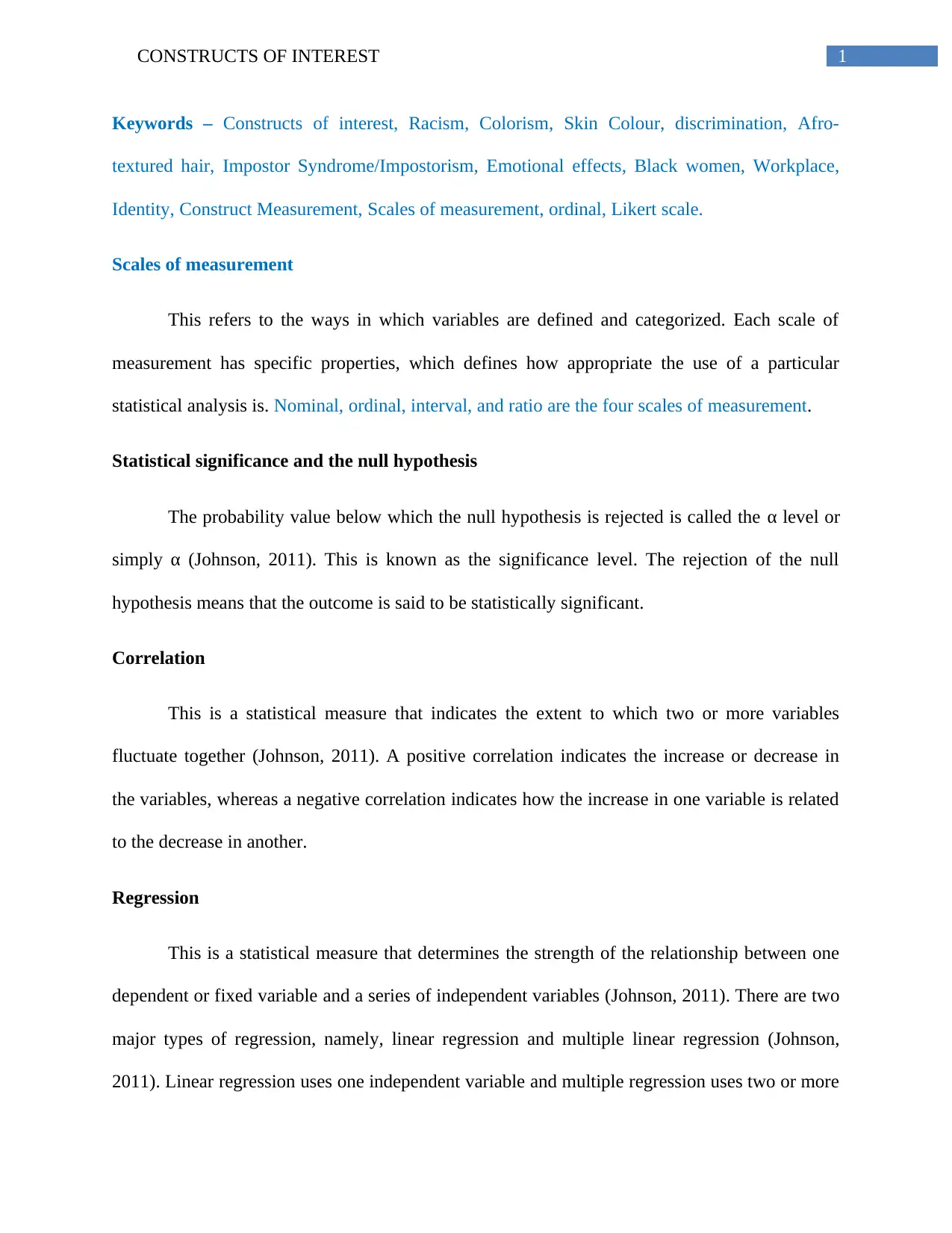
1CONSTRUCTS OF INTEREST
Keywords – Constructs of interest, Racism, Colorism, Skin Colour, discrimination, Afro-
textured hair, Impostor Syndrome/Impostorism, Emotional effects, Black women, Workplace,
Identity, Construct Measurement, Scales of measurement, ordinal, Likert scale.
Scales of measurement
This refers to the ways in which variables are defined and categorized. Each scale of
measurement has specific properties, which defines how appropriate the use of a particular
statistical analysis is. Nominal, ordinal, interval, and ratio are the four scales of measurement.
Statistical significance and the null hypothesis
The probability value below which the null hypothesis is rejected is called the α level or
simply α (Johnson, 2011). This is known as the significance level. The rejection of the null
hypothesis means that the outcome is said to be statistically significant.
Correlation
This is a statistical measure that indicates the extent to which two or more variables
fluctuate together (Johnson, 2011). A positive correlation indicates the increase or decrease in
the variables, whereas a negative correlation indicates how the increase in one variable is related
to the decrease in another.
Regression
This is a statistical measure that determines the strength of the relationship between one
dependent or fixed variable and a series of independent variables (Johnson, 2011). There are two
major types of regression, namely, linear regression and multiple linear regression (Johnson,
2011). Linear regression uses one independent variable and multiple regression uses two or more
Keywords – Constructs of interest, Racism, Colorism, Skin Colour, discrimination, Afro-
textured hair, Impostor Syndrome/Impostorism, Emotional effects, Black women, Workplace,
Identity, Construct Measurement, Scales of measurement, ordinal, Likert scale.
Scales of measurement
This refers to the ways in which variables are defined and categorized. Each scale of
measurement has specific properties, which defines how appropriate the use of a particular
statistical analysis is. Nominal, ordinal, interval, and ratio are the four scales of measurement.
Statistical significance and the null hypothesis
The probability value below which the null hypothesis is rejected is called the α level or
simply α (Johnson, 2011). This is known as the significance level. The rejection of the null
hypothesis means that the outcome is said to be statistically significant.
Correlation
This is a statistical measure that indicates the extent to which two or more variables
fluctuate together (Johnson, 2011). A positive correlation indicates the increase or decrease in
the variables, whereas a negative correlation indicates how the increase in one variable is related
to the decrease in another.
Regression
This is a statistical measure that determines the strength of the relationship between one
dependent or fixed variable and a series of independent variables (Johnson, 2011). There are two
major types of regression, namely, linear regression and multiple linear regression (Johnson,
2011). Linear regression uses one independent variable and multiple regression uses two or more

2CONSTRUCTS OF INTEREST
independent variables to predict the outcome of the dependent variable depicted by Y. Another
type of regression is the multivariate regression where two or more independent variables are
analyzed to determine multiple outcomes for the dependent variables.
Constructs of interest.
The following are the constructs that I am considering to assess in my dissertation.
1. Perception of Colorism – Colorism is defined as the form of prejudice of discrimination
based on skin color and shade of a person or a group of people usually from the same
racial descent (Wilder & Cain, 2011). In the current context of the study, colorism is
identified as a construct in order to aid the study of its emotional effects on the Black
Women in Workplace. Research indicates that the problem of occupational
discrimination based on colorism is significantly high, however understudied (Marira &
Mitra, 2013). Colorism in workplace is responsible for a multitude of emotional
influences ranging from interpersonal workplace hostility to personal issues with
depression and anxiety, especially prevalent due to the persistent discrimination in
processes of hiring and employment based on skin tone (Zschirnt & Ruedin, 2016).
2. Perception of Discrimination based on hair texture – In this aspect, the discrimination
that occurs is mostly based on the varied textures of hair (Robinson, 2011) that is
prevalent among the African American women, most commonly known as Afro-Textured
hair (Miller, 2016). Afro-Textured hair is considered a racial identity for black
individuals, especially women. While there is no formal name for this construct, the
effects of discrimination of Black women in workplace based on their hair texture has
been indicated to negatively impact the psychological and productive wellbeing of the
concerned people (Rosette & Dumas, 2007).
independent variables to predict the outcome of the dependent variable depicted by Y. Another
type of regression is the multivariate regression where two or more independent variables are
analyzed to determine multiple outcomes for the dependent variables.
Constructs of interest.
The following are the constructs that I am considering to assess in my dissertation.
1. Perception of Colorism – Colorism is defined as the form of prejudice of discrimination
based on skin color and shade of a person or a group of people usually from the same
racial descent (Wilder & Cain, 2011). In the current context of the study, colorism is
identified as a construct in order to aid the study of its emotional effects on the Black
Women in Workplace. Research indicates that the problem of occupational
discrimination based on colorism is significantly high, however understudied (Marira &
Mitra, 2013). Colorism in workplace is responsible for a multitude of emotional
influences ranging from interpersonal workplace hostility to personal issues with
depression and anxiety, especially prevalent due to the persistent discrimination in
processes of hiring and employment based on skin tone (Zschirnt & Ruedin, 2016).
2. Perception of Discrimination based on hair texture – In this aspect, the discrimination
that occurs is mostly based on the varied textures of hair (Robinson, 2011) that is
prevalent among the African American women, most commonly known as Afro-Textured
hair (Miller, 2016). Afro-Textured hair is considered a racial identity for black
individuals, especially women. While there is no formal name for this construct, the
effects of discrimination of Black women in workplace based on their hair texture has
been indicated to negatively impact the psychological and productive wellbeing of the
concerned people (Rosette & Dumas, 2007).
⊘ This is a preview!⊘
Do you want full access?
Subscribe today to unlock all pages.

Trusted by 1+ million students worldwide
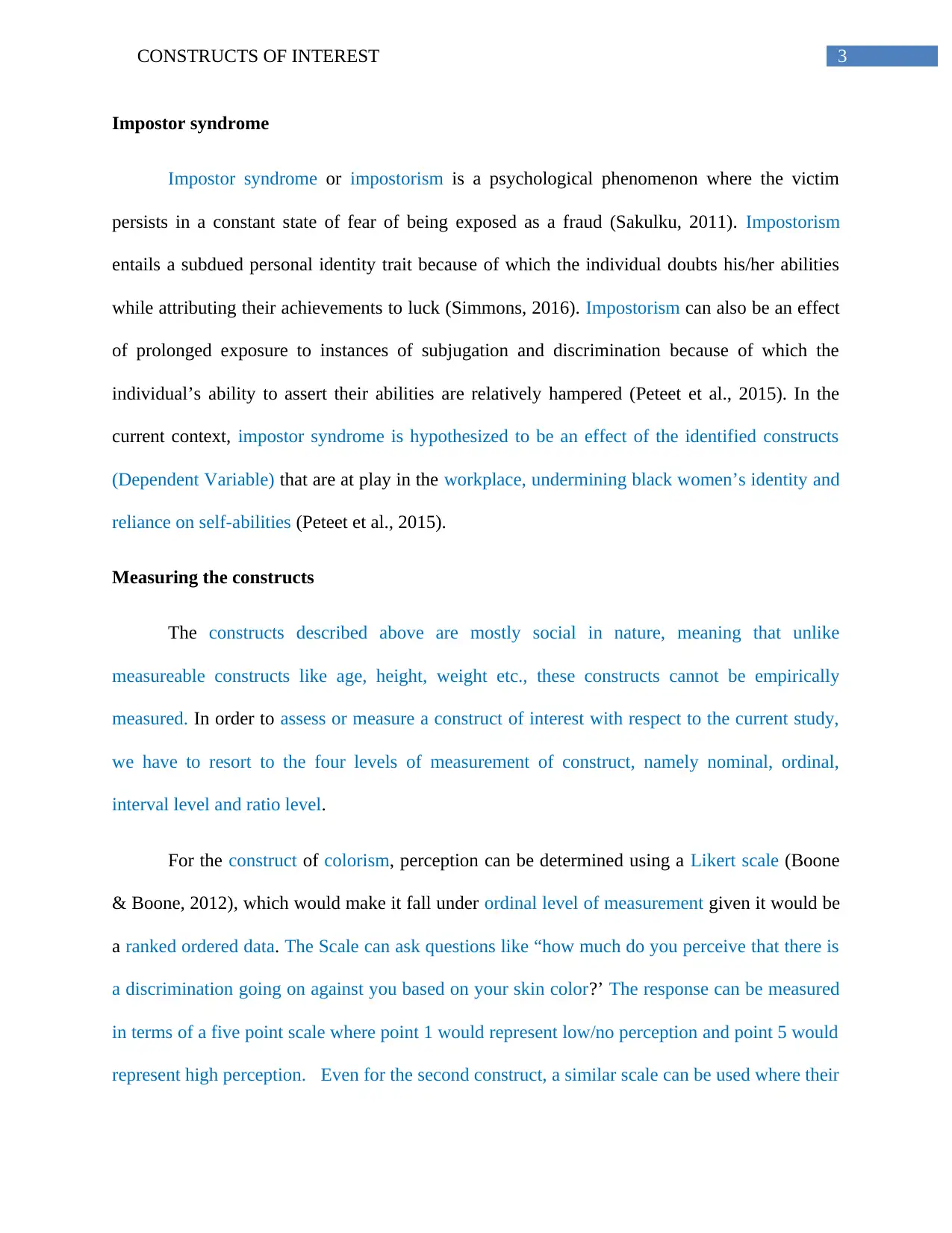
3CONSTRUCTS OF INTEREST
Impostor syndrome
Impostor syndrome or impostorism is a psychological phenomenon where the victim
persists in a constant state of fear of being exposed as a fraud (Sakulku, 2011). Impostorism
entails a subdued personal identity trait because of which the individual doubts his/her abilities
while attributing their achievements to luck (Simmons, 2016). Impostorism can also be an effect
of prolonged exposure to instances of subjugation and discrimination because of which the
individual’s ability to assert their abilities are relatively hampered (Peteet et al., 2015). In the
current context, impostor syndrome is hypothesized to be an effect of the identified constructs
(Dependent Variable) that are at play in the workplace, undermining black women’s identity and
reliance on self-abilities (Peteet et al., 2015).
Measuring the constructs
The constructs described above are mostly social in nature, meaning that unlike
measureable constructs like age, height, weight etc., these constructs cannot be empirically
measured. In order to assess or measure a construct of interest with respect to the current study,
we have to resort to the four levels of measurement of construct, namely nominal, ordinal,
interval level and ratio level.
For the construct of colorism, perception can be determined using a Likert scale (Boone
& Boone, 2012), which would make it fall under ordinal level of measurement given it would be
a ranked ordered data. The Scale can ask questions like “how much do you perceive that there is
a discrimination going on against you based on your skin color?’ The response can be measured
in terms of a five point scale where point 1 would represent low/no perception and point 5 would
represent high perception. Even for the second construct, a similar scale can be used where their
Impostor syndrome
Impostor syndrome or impostorism is a psychological phenomenon where the victim
persists in a constant state of fear of being exposed as a fraud (Sakulku, 2011). Impostorism
entails a subdued personal identity trait because of which the individual doubts his/her abilities
while attributing their achievements to luck (Simmons, 2016). Impostorism can also be an effect
of prolonged exposure to instances of subjugation and discrimination because of which the
individual’s ability to assert their abilities are relatively hampered (Peteet et al., 2015). In the
current context, impostor syndrome is hypothesized to be an effect of the identified constructs
(Dependent Variable) that are at play in the workplace, undermining black women’s identity and
reliance on self-abilities (Peteet et al., 2015).
Measuring the constructs
The constructs described above are mostly social in nature, meaning that unlike
measureable constructs like age, height, weight etc., these constructs cannot be empirically
measured. In order to assess or measure a construct of interest with respect to the current study,
we have to resort to the four levels of measurement of construct, namely nominal, ordinal,
interval level and ratio level.
For the construct of colorism, perception can be determined using a Likert scale (Boone
& Boone, 2012), which would make it fall under ordinal level of measurement given it would be
a ranked ordered data. The Scale can ask questions like “how much do you perceive that there is
a discrimination going on against you based on your skin color?’ The response can be measured
in terms of a five point scale where point 1 would represent low/no perception and point 5 would
represent high perception. Even for the second construct, a similar scale can be used where their
Paraphrase This Document
Need a fresh take? Get an instant paraphrase of this document with our AI Paraphraser
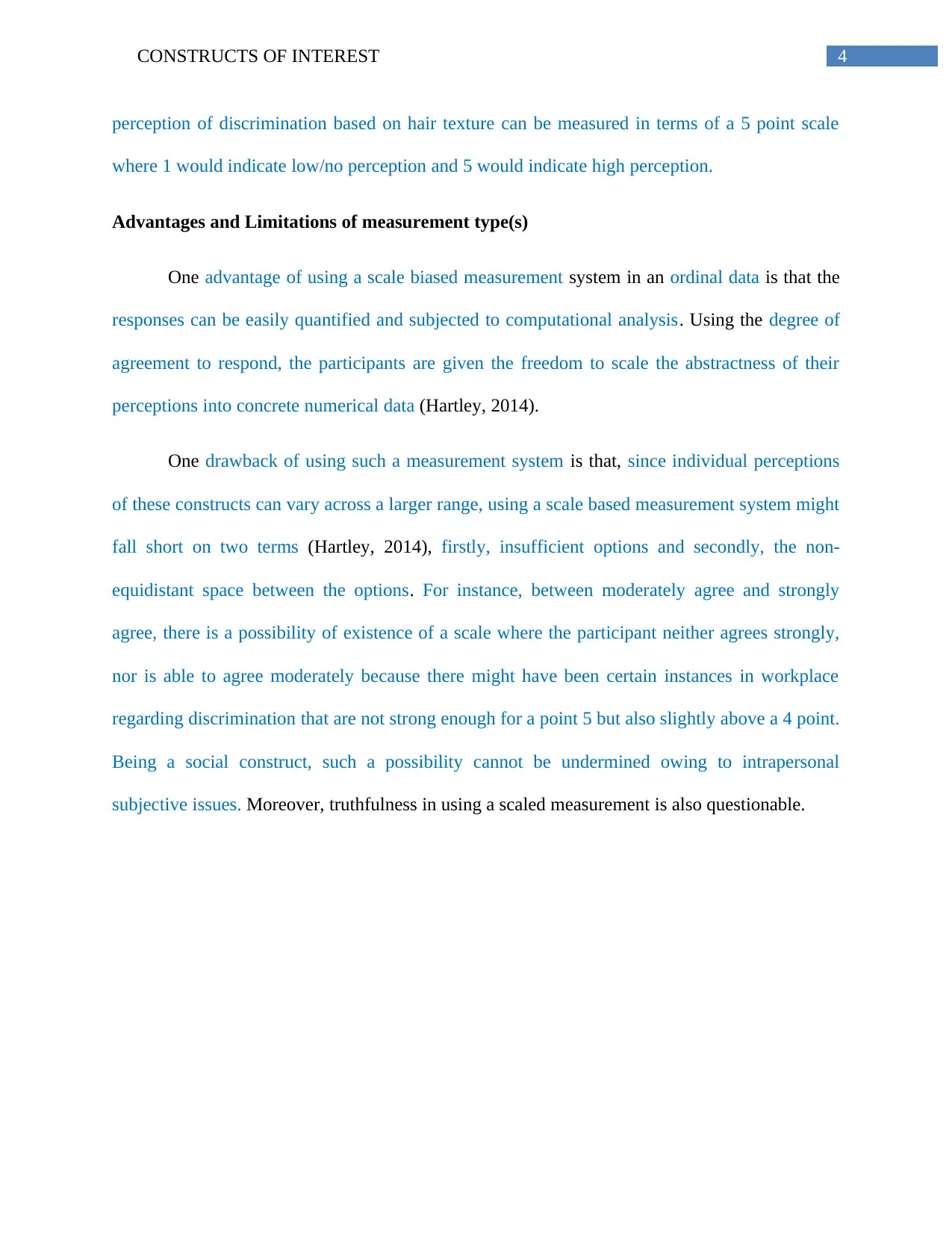
4CONSTRUCTS OF INTEREST
perception of discrimination based on hair texture can be measured in terms of a 5 point scale
where 1 would indicate low/no perception and 5 would indicate high perception.
Advantages and Limitations of measurement type(s)
One advantage of using a scale biased measurement system in an ordinal data is that the
responses can be easily quantified and subjected to computational analysis. Using the degree of
agreement to respond, the participants are given the freedom to scale the abstractness of their
perceptions into concrete numerical data (Hartley, 2014).
One drawback of using such a measurement system is that, since individual perceptions
of these constructs can vary across a larger range, using a scale based measurement system might
fall short on two terms (Hartley, 2014), firstly, insufficient options and secondly, the non-
equidistant space between the options. For instance, between moderately agree and strongly
agree, there is a possibility of existence of a scale where the participant neither agrees strongly,
nor is able to agree moderately because there might have been certain instances in workplace
regarding discrimination that are not strong enough for a point 5 but also slightly above a 4 point.
Being a social construct, such a possibility cannot be undermined owing to intrapersonal
subjective issues. Moreover, truthfulness in using a scaled measurement is also questionable.
perception of discrimination based on hair texture can be measured in terms of a 5 point scale
where 1 would indicate low/no perception and 5 would indicate high perception.
Advantages and Limitations of measurement type(s)
One advantage of using a scale biased measurement system in an ordinal data is that the
responses can be easily quantified and subjected to computational analysis. Using the degree of
agreement to respond, the participants are given the freedom to scale the abstractness of their
perceptions into concrete numerical data (Hartley, 2014).
One drawback of using such a measurement system is that, since individual perceptions
of these constructs can vary across a larger range, using a scale based measurement system might
fall short on two terms (Hartley, 2014), firstly, insufficient options and secondly, the non-
equidistant space between the options. For instance, between moderately agree and strongly
agree, there is a possibility of existence of a scale where the participant neither agrees strongly,
nor is able to agree moderately because there might have been certain instances in workplace
regarding discrimination that are not strong enough for a point 5 but also slightly above a 4 point.
Being a social construct, such a possibility cannot be undermined owing to intrapersonal
subjective issues. Moreover, truthfulness in using a scaled measurement is also questionable.
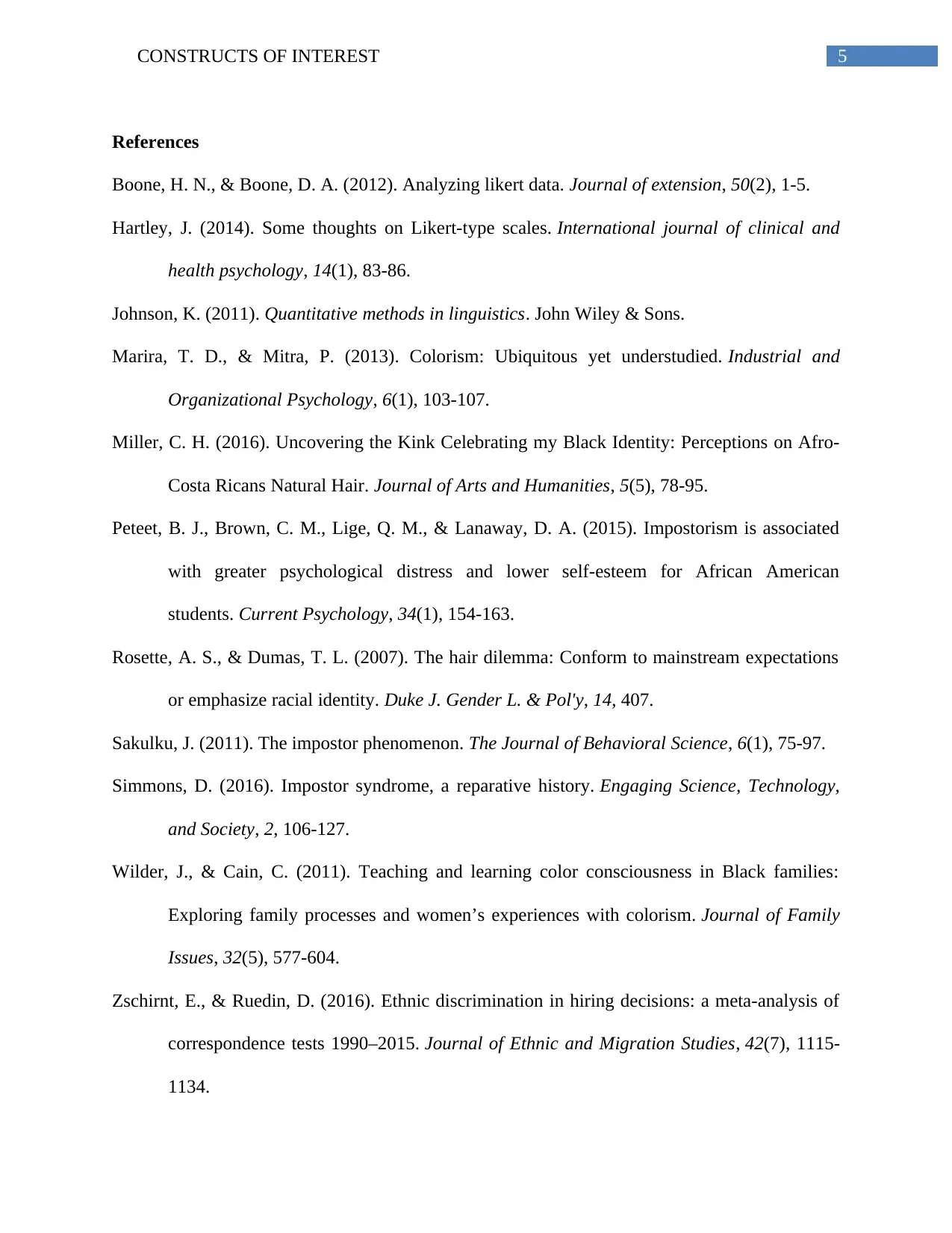
5CONSTRUCTS OF INTEREST
References
Boone, H. N., & Boone, D. A. (2012). Analyzing likert data. Journal of extension, 50(2), 1-5.
Hartley, J. (2014). Some thoughts on Likert-type scales. International journal of clinical and
health psychology, 14(1), 83-86.
Johnson, K. (2011). Quantitative methods in linguistics. John Wiley & Sons.
Marira, T. D., & Mitra, P. (2013). Colorism: Ubiquitous yet understudied. Industrial and
Organizational Psychology, 6(1), 103-107.
Miller, C. H. (2016). Uncovering the Kink Celebrating my Black Identity: Perceptions on Afro-
Costa Ricans Natural Hair. Journal of Arts and Humanities, 5(5), 78-95.
Peteet, B. J., Brown, C. M., Lige, Q. M., & Lanaway, D. A. (2015). Impostorism is associated
with greater psychological distress and lower self-esteem for African American
students. Current Psychology, 34(1), 154-163.
Rosette, A. S., & Dumas, T. L. (2007). The hair dilemma: Conform to mainstream expectations
or emphasize racial identity. Duke J. Gender L. & Pol'y, 14, 407.
Sakulku, J. (2011). The impostor phenomenon. The Journal of Behavioral Science, 6(1), 75-97.
Simmons, D. (2016). Impostor syndrome, a reparative history. Engaging Science, Technology,
and Society, 2, 106-127.
Wilder, J., & Cain, C. (2011). Teaching and learning color consciousness in Black families:
Exploring family processes and women’s experiences with colorism. Journal of Family
Issues, 32(5), 577-604.
Zschirnt, E., & Ruedin, D. (2016). Ethnic discrimination in hiring decisions: a meta-analysis of
correspondence tests 1990–2015. Journal of Ethnic and Migration Studies, 42(7), 1115-
1134.
References
Boone, H. N., & Boone, D. A. (2012). Analyzing likert data. Journal of extension, 50(2), 1-5.
Hartley, J. (2014). Some thoughts on Likert-type scales. International journal of clinical and
health psychology, 14(1), 83-86.
Johnson, K. (2011). Quantitative methods in linguistics. John Wiley & Sons.
Marira, T. D., & Mitra, P. (2013). Colorism: Ubiquitous yet understudied. Industrial and
Organizational Psychology, 6(1), 103-107.
Miller, C. H. (2016). Uncovering the Kink Celebrating my Black Identity: Perceptions on Afro-
Costa Ricans Natural Hair. Journal of Arts and Humanities, 5(5), 78-95.
Peteet, B. J., Brown, C. M., Lige, Q. M., & Lanaway, D. A. (2015). Impostorism is associated
with greater psychological distress and lower self-esteem for African American
students. Current Psychology, 34(1), 154-163.
Rosette, A. S., & Dumas, T. L. (2007). The hair dilemma: Conform to mainstream expectations
or emphasize racial identity. Duke J. Gender L. & Pol'y, 14, 407.
Sakulku, J. (2011). The impostor phenomenon. The Journal of Behavioral Science, 6(1), 75-97.
Simmons, D. (2016). Impostor syndrome, a reparative history. Engaging Science, Technology,
and Society, 2, 106-127.
Wilder, J., & Cain, C. (2011). Teaching and learning color consciousness in Black families:
Exploring family processes and women’s experiences with colorism. Journal of Family
Issues, 32(5), 577-604.
Zschirnt, E., & Ruedin, D. (2016). Ethnic discrimination in hiring decisions: a meta-analysis of
correspondence tests 1990–2015. Journal of Ethnic and Migration Studies, 42(7), 1115-
1134.
⊘ This is a preview!⊘
Do you want full access?
Subscribe today to unlock all pages.

Trusted by 1+ million students worldwide

6CONSTRUCTS OF INTEREST
1 out of 7
Your All-in-One AI-Powered Toolkit for Academic Success.
+13062052269
info@desklib.com
Available 24*7 on WhatsApp / Email
![[object Object]](/_next/static/media/star-bottom.7253800d.svg)
Unlock your academic potential
Copyright © 2020–2025 A2Z Services. All Rights Reserved. Developed and managed by ZUCOL.


